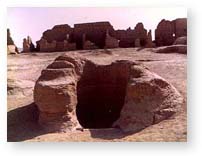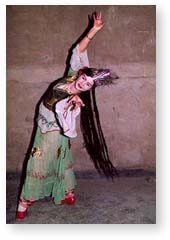 Silk Road |

|
2. Turfan's Karez
It looks as if there is water swaying and shining in the distance, but as you come closer, it moves farther away. It is nigemizu (water which runs away)- a mirage. There are no flying birds in the sky and no running beasts on the ground. The red sandstone of the Flaming Mountain, well-known from the Journey to the West, was baked by the sun's strong rays and a heat haze rose up like a burning fire. It's a scorching hell.
Suddenly, an oasis appeared, surrounded by dark green grape trellises and several rows of poplar trees. The Turfan Depression, 154 meters below sea level, is the world's lowest land. The wells which draw water from the melted snow of the Tian Shan Mountains are the water of life for the people and greenery. Dug at regular intervals, the vertical wells (karez, about 20 meters deep), using of the mountains' natural slope and lengthened tunnels, are consecutively connected to the oasis. The karez, used by the sand people since long ago, is pleasantly cool inside and the water is cold and sweet. Cultivated with water from melted snow, the seedless white grapes, ma nai, are respected as the pearls of the desert, and ma nai wine and raisins are sold on the Japanese market. Turfan could almost be called a wind storehouse as clouds of sand and dust are always dancing in the air. The instant that the wind settles, brightly-dressed Uygur girls, with the clinking sound of their earrings and arm bracelets, appeared in a large group from the middle of a cloud of dust, almost out of nowhere, like a vision. Of mixed Turkish, Iranian and Slav descent, there are many bewitching beauties.
At night, under the grape trellises, the Uygur people held an dreamy welcome dance. Accompanied by the rawap (a stringed instrument similar to the Indian sitar or guitar), the maidens dressed in gaudy clothes, their delicate limbs and long hair twisting, perform an intense dance, Hu xuan wu. The suggestive dance and melodies, which have charmed many heroes and poets, recalled to my mind the belly dance of the Middle East or the gypsy dance of Spain. Bai Le Tian was also fascinated by the Hu xuan wu and wrote the following: "Hu xuan nu, Hu xuan nu, your heart responds to the bow, your hand to the drum, two arms raise with one note of the string and drum..." Spending the days with song and dance, the big-hearted Uygur people are actually stubborn and formidably clever. Sandwiched between strong countries and being ruled by others, in the end, they have persisted with their own manners, customs and language and have survived in a dignified manner in any era. Did they gain the understanding of techniques for how to live without resisting, knowing the vanity of power, through history? After that visit, I returned to Turfan many times. The rows of poplar trees grow taller and denser year by year. The uneven road has been paved, and the crumbling mud brick ruins have been repaired. By repairing the inheritance which was damaged by the years' snowstorms, they have actually destroyed it. Leaving heritage to the next generations is important, but I felt that the way to repair it must be difficult. LinksMap of Turfan Photos of Turfan Copyright1998 Setsuko Watanabe
|
- Return -
- back to home -

